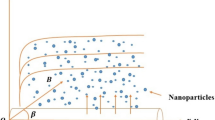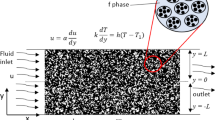Abstract
A mathematical model for supercritical water natural circulation loop (SCWNCL) is developed to study flow instabilities by linear stability analysis. The SCWNCL is a loop geometry, which is driven by natural circulation with supercritical water (SCW) as a coolant. A mathematical approach is developed to couple thermal-hydraulic (TH) model and neutron point kinetics (NPK) model. This nuclear coupled model is then used to perform a linear asymptotic stability analysis of the steady state of SCWNCL. A comprehensive numerical study of the linear asymptotic stability analysis is presented with particular emphasis on the effects of coupling. As a result of coupling, a transition from unstable to the stable region and vice-versa is observed for some governing parameter values, which is significantly different from the TH model. Furthermore, the stable operating zone’s are investigated by taking appropriate geometrical and operating conditions via stability analysis.
Similar content being viewed by others
Abbreviations
- A :
-
Cross sectional area
- D :
-
Loop diameter
- g :
-
Acceleration due to gravity
- e :
-
Total specific internal energy
- e f :
-
Total specific flow energy
- f :
-
Friction factor
- h :
-
Specific enthalpy
- W :
-
Mass flow rate
- K :
-
Loss coefficient
- p :
-
Pressure
- H :
-
Vertical height
- q ″w :
-
Heat flux per unit area
- v :
-
Specific volume
- P w :
-
Wetted perimeter
- P h :
-
Heated perimeter
- L :
-
Length of the section
- u :
-
Velocity vector field
- T sup :
-
Coolant temperature at superheated conditions
- H f :
-
Heat transfer coefficient
- a f :
-
Heat transfer area of fuel rod
- m f :
-
Mass of fuel rod
- δ :
-
Dirac-delta operator
- φ :
-
Inclination angle
- ρ :
-
Density of the fluid
- T w :
-
Wall shear stress
- β :
-
Total fraction of delayed neutron
- β m :
-
Delayed neutron fraction of delayed neutron group of m
- λ m :
-
Decay constant of delayed neutron group of m
- Λ:
-
Prompt neutron life time
- In :
-
Inlet
- av :
-
Average
- h :
-
Heater
- c :
-
Cooler
- ss :
-
Steady state
References
V. Chatoorgoon, Stability of supercritical fluid flow in a single-channel natural-convection loop, International Journal of Heat and Mass Transfer, 44 (2001) 1963–1972.
W. Ambrosini and M. Sharabi, Dimensionless parameters in stability analysis of heated channels with fluids at supercritical pressures, Nuclear Engineering and Design, 238 (2008) 1917–1929.
I. L. Pioro, Handbook of Generation IV Nuclear Reactors, Woodhead Publishing Series in Energy, Elsevier, UK (2016).
IAEATECDOC-1474, Natural Circulation in Water Cooled Nuclear Power Plants, International Atomic Energy Agency, Vienna, Austria (2005).
IAEATECDOC-1677, Natural Circulation Phenomena and Modeling for Advanced Water Cooled Reactors, International Atomic Energy Agency, Vienna, Austria (2012).
T. Srivastava, P. Sutradhar, M. K. S. Sarkar and D. N. Basu, Advancements in Supercritical Fluids Applications for Sustainable Energy Systems, IGI Publisher, USA (2017).
M. K. S. Sarkar, A. K. Tilak and D. N. Basu, A state-of-the-art review of recent advances in supercritical natural circulation loops for nuclear applications, Annals of Nuclear Energy, 73 (2014) 250–263.
D. N. Basu, S. Bhattacharyya and P. K. Das, A review of modern advances in analyses and applications of single-phase natural circulation loop in nuclear thermal hydraulics, Nuclear Engineering and Design, 280 (2014) 326–348.
D. D. B. van Bragt and T. H. J. J. van der Hagen, Stability of natural circulation boiling water reactors: part i-description stability model and theoretical analysis in terms of dimensionless groups, Nuclear Technology, 121 (1998) 40–51.
K. S. Bhambare, S. K. Mitra and U. N. Gaitonde, Modeling of a coal-fired natural circulation boiler, Journal of Energy Resources Technology, 129 (2007) 159–167.
M. Sharma, P. K. Vijayan, D. S. Pilkhwal, D. Saha and R. K. Sinha, Steady state and linear stability analysis of a supercritical water natural circulation loop, Nuclear Engineering and Design, 240 (2010) 588–597.
D. S. Pikhwal, M. Sharma, S. S. Jana and P. K. Vijayan, Experiments in a Natural Circulation Loop with Supercritical Water at Low Powers, No. BARC-2013/E/013, Bhabha Atomic Research Centre, Mumbai, India (2013).
M. Sharma, P. K. Vijayan, D. S. Pilkhwal, D. Saha and R. K. Sinha, Linear and nonlinear stability analysis of a supercritical natural circulation loop, Journal of Engineering for Gas Turbines and Power, 132 (2010) 102904–1–102904–9.
P. K. Jain and Rizwanuddin, Numerical analysis of supercritical flow instabilities in a natural circulation loop, Nuclear Engineering and Design, 238(8) (2008) 1947–1957.
M. Sharma, P. K. Vijayan, D. S. Pilkhwal and Y. Asako, Natural convective flow and heat transfer studies for supercritical water in a rectangular circulation loop, Nuclear Engineering and Design, 273 (2014) 304–320.
R. Upadhyay, S. K. Rai and G. Dutta, Numerical analysis of density wave instability and heat transfer deterioration in a supercritical water reactor, Journal of Mechanical Sciences and Technology, 32(3) (2018) 1063–1070.
R. Upadhyay, N. S. Raghuvanshi and G. Dutta, Numerical analysis of parallel-channel density wave instabilities in a supercritical water reactor, Journal of the Brazilian Society of Mechanical Sciences and Engineering, 42(3) (2020) 1–18.
T. T. Yi, S. Koshizuka and Y. Oka, A linear stability analysis of supercritical water reactors, (I) thermal-hydraulic stability, Journal of Nuclear Science and Technology, 41(12) (2004) 1166–1175.
R. Jain and M. L. Corradini, A linear stability analysis for natural-circulation loops under supercritical conditions, Nuclear Technology, 155 (2016) 312–323.
T. O. Gomez, A. Class, R. T. Lahey Jr. and T. Schulenberg, Stability analysis of a uniformly heated channel with supercritical water, Nuclear Engineering and Design, 238 (2008) 1930–1939.
G. Dutta and Y. Giridhar, Nuclear coupled thermal hydraulic analysis of fast transient depressurization in supercritical channels, International Journal of Numerical Methods for Heat and Fluid Flow, 27(5) (2017) 1158–1171.
G. G. Theler and F. J. Bonetto, On the stability of the point reactor kinetics equations, Nuclear Engineering and Design, 240 (2010) 1443–1449.
V. A. Kale, R. Kumar, K. Obaidurrahman and A. J. Gaikwad, Linear stability analysis of a nuclear reactor using the lumped model, Nuclear Technology and Radiation Protection, 31(3) (2016) 218–227.
T. T. Yi, S. Koshizuka and Y. Oka, A linear stability analysis of supercritical water reactors, (II) coupled neutronic thermalhydraulic stability, Journal of Nuclear Science and Technology, 41(12) (2004) 1176–1186.
G. Dutta, R. Maitri, C. Zhang and J. Jiang, Numerical model to predict steady and unsteady thermal-hydraulic behavior of supercritical water flow in circular tubes, Nuclear Engineering and Design, 280 (2015) 155–165.
S. Mokry, I. Pioro, A. Farah, K. King, S. Gupta, W. Peiman and P. Kirillov, Development of supercritical water heat-transfer correlation for vertical bare tubes, Nuclear Engineering and Design, 241(4) (2011) 1126–1136.
I. L. Pioro, H. F. Khartabil and R. B. Duffey, Heat transfer to supercritical fluids flowing in channels, empirical correlations (survey), Nuclear Engineering and Design, 230(1–3) (2004) 69–91.
H. S. Swenson, J. R. Carver and C. R. Kakarala, Heat transfer to supercritical water in smooth-bore tubes, Journal of Heat Transfer Trans. ASME Ser., c87(4) (1965) 477–484.
G. Dutta and J. B. Doshi, Nonlinear analysis of nuclear coupled density wave instability in time domain for a boiling water reactor core undergoing core-wide and regional modes of oscillations, Progress in Nuclear Energy, 51 (2009) 769–787.
G. Dutta and J. B. Doshi, A charactristics-based implicit finite-difference scheme for the analysis of instability in water cooled reactors, Nuclear Engineering and Technology, 40(6) (2008) 477–488.
A. Harvey, A. Peskin and S. Klein, NIST/ASME Steam Properties, Version 3.0, US Department of Commerce, Technology Administration (2013).
Acknowledgments
The authors would like to acknowledge PDPM Indian Institute of Information Technology, Design, and Manufacturing (IIITDM), Jabalpur for the financial funding as well as providing the computational facility.
Author information
Authors and Affiliations
Corresponding author
Additional information
Neetesh Singh Raghuvanshi received his B.E. in Mechanical Engineering from RGPV, Bhopal, India in 2011, and his M.Tech. from MANIT, Bhopal, India in 2014. He is currently a Ph.D. research scholar working in the field of linear and nonlinear stability analysis of nuclear reactor at PDPM IIITDM, Jabalpur, India.
Goutam Dutta received his Ph.D. and M. Tech. degrees from IIT, Mumbai, India in 2008 and 2003, all in Mechanical Engineering. He is currently working as an Associate Professor in the Mechanical Engineering Department at IIT, Jammu, India. His research interests are heat transfer, computational fluid dynamics and 3-D-space kinetics.
Manoj Kumar Panda received his Ph.D. degree from IIT, Kanpur, India in 2011. He is currently working as an Assistant Professor in the natural science discipline at PDPM IIITDM, Jabalpur, India. His research interests include applied partial & ordinary differential equations, mathematical modelling and scientific computing (analytical & numerical study).
Rights and permissions
About this article
Cite this article
Raghuvanshi, N.S., Dutta, G. & Panda, M.K. Identification of stable zone via linear stability analysis of supercritical water natural circulation loop. J Mech Sci Technol 35, 747–759 (2021). https://doi.org/10.1007/s12206-021-0135-x
Received:
Revised:
Accepted:
Published:
Issue Date:
DOI: https://doi.org/10.1007/s12206-021-0135-x




